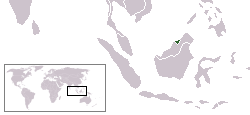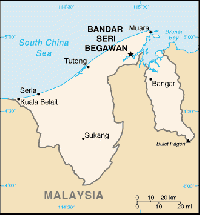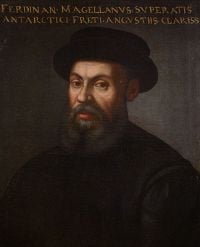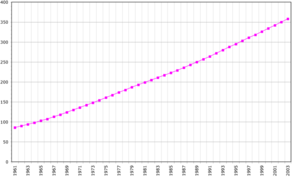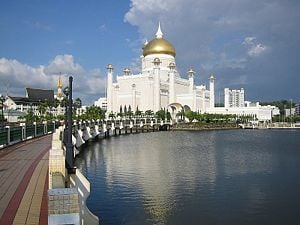Brunei
| بروني دارالسلام Negara Brunei Darussalam State of Brunei Darussalam | |||||
| |||||
| Motto: "Always in service with God's guidance" (translation) | |||||
| Anthem: Allah Peliharakan Sultan "God Bless the Sultan" | |||||
| Capital (and largest city) |
Bandar Seri Begawan 4°53.417′N 114°56.533′E | ||||
| Official languages | Malay (national), English | ||||
|---|---|---|---|---|---|
| Government | Unitary Islamic sultanate | ||||
| - Sultan | Hassanal Bolkiah | ||||
| - Crown Prince | Al-Muhtadee Billah | ||||
| - Prime Minister | Hassanal Bolkiah | ||||
| Formation | |||||
| - Sultanate | 14th century | ||||
| - End of British protectorate |
January 1, 1984 | ||||
| Area | |||||
| - Total | 5,765 km² (172nd) 2,226 sq mi | ||||
| - Water (%) | 8.6 | ||||
| Population | |||||
| - 2011 estimate | 401,890 | ||||
| - 2001 census | 332,844 | ||||
| - Density | 67.3/km² 174.4/sq mi | ||||
| GDP (PPP) | 2010 estimate | ||||
| - Total | $20.382 billion | ||||
| - Per capita | $48,891 | ||||
| GDP (nominal) | 2010 estimate | ||||
| - Total | $13.022 billion | ||||
| - Per capita | $31,238 | ||||
| HDI (2004) | |||||
| Currency | Brunei ringgit (BND)
| ||||
| Internet TLD | .bn | ||||
| Calling code | +6731 | ||||
Brunei, officially the State of Brunei, Abode of Peace (Negara Brunei Darussalam), Jawi: برني دارالسلام ), is a country located on the island of Borneo, in Southeast Asia. Apart from its coastline with the South China Sea, it is surrounded by the states of Sarawak and Sabah, East Malaysia. Brunei, the remnant of a powerful sultanate, became independent from the United Kingdom in 1984.
As a constitutional sultanate, Brunei was, in 2007, the only country in the world not holding elections. A long period of political stability has been attributed to absolute rule.
The nation has long benefited from its strategic location between China and the trading networks of Southeast Asia. Petroleum wealth has allowed the Brunei government to provide the population with one of Asia's finest health care systems, and invest in the state religion, Islam.
Geography
Located on the island of Borneo in Southeast Asia, Brunei borders the South China Sea and the Malaysian states of Sabah and Sarawak. The total land area is 2,228 square miles (5770 square kilometers), which is slightly smaller than the U.S. state of Delaware.
Brunei consists of two unconnected sections which are physically separated by Malaysia, making it almost an enclave within Malaysia. Approximately 97 percent of the population lives in the larger western part, while only about 10,000 live in the mountainous eastern section, the district of Temburong. It is close to vital sea lanes through the South China Sea linking the Indian and Pacific oceans.
The terrain comprises a flat coastal plain that rises to mountains in the east, and hilly lowland in the west. The highest point is Bukit Pagon at 6,069 feet (1850 meters). Its natural resources include petroleum, natural gas, and timber.
About 75 percent of the country is covered with mangrove, heath, peat swamp, mixed dipterocarp, and montane forests. Log exports have been banned. There are numerous rivers, whose broad valleys contain most settlements. The southern part of Temburong is mountainous and sparsely populated.
The climate in Brunei is equatorial tropical, with high temperatures, high humidity, abundant sunshine, and heavy rainfall throughout the year.
Typhoons, earthquakes, and severe flooding are rare to Brunei. The only environmental issue relates to seasonal smoke and haze resulting from forest fires in Indonesia.
The total population of Brunei is 383,000, of which around 46,000 live in the capital Bandar Seri Begawan. Other towns include the port Muara, the oil-producing town of Seria, and its neighboring town, Kuala Belait. In the Belait district, the Panaga area is home to large numbers of expatriates due to Royal Dutch Shell and British Army housing and recreational facilities. The well-known Panaga Club is situated here.
History
The origins of Brunei are only dimly known. Chinese and Arabic records indicate that the trading kingdom of Po-ni existed at the mouth of the Brunei River as early as the seventh or eighth century C.E. By the tenth century, Po-ni had a close mercantile relationship with China’s Song Dynasty and later the Ming Dynasty.
Traditions speak of local Bornean culture heroes, including Hawang Halak Batatar, who adopted Islam and became the first Muslim sultan of Brunei, Muhammad Shah, and ruled from 1363 to 1402. He and his brother, the second sultan, were the start of the Barunay aristocrats, who trace their origins to the Pagar Uyung area of the Minangakabau highlands of Sumatra.
By the fourteenth century, Po-ni also fell under the influence of the Javanese Majapahit Empire. In 1408, the Po-ni ruler Kala visited China and died there. At that time, the Chinese admiral Zheng He described a visit to a large trading port at Po-ni where numerous Chinese traders operated. In 1424, the Hongxi Emperor ended China's maritime program, and the mainland's relationship with Po-ni ended.
The third sultan, Sharif Ali (r. 1425–1433), who married a daughter of Sultan Ahmad, came from Arabia and was a descendant of the Prophet Muhammad. By the middle of the fifteenth century the state entered into a close relationship with the Sultanate of Malacca.
The sultanate was a thalassocracy, a realm based more on controlling trade than land. Situated in a strategic location between China and the trading networks of Southeast Asia, the state served as an entrepot and collected tolls on water traffic. The society was hierarchical, with the sultan serving as despot. His powers were limited by a council of princes, whose duties included arranging for royal succession.
The reign of the fifth sultan, Bolkiah (1485–1521), who began the dynasty that continues to this day, is often marked as Brunei's "golden age." The conquest of Malacca by the Portuguese in 1511 meant Brunei benefited from the scattering of Muslim merchants and traders who were forced to use other ports. The sultanate's control extended over the coastal regions of modern-day Sarawak and Sabah (later part of Malaysia), the Sulu archipelago (later part of the Philippines), and the islands off the northwest tip of Borneo. The sultanate's influence also spread north into Manila Bay, where colonies were planted,
At the end of Bolkiah's reign, in 1521, Magellen's expedition brought the first Europeans to Brunei. Antonio Pigafetta, a navigator on the trip, described an amazing city. The Europeans rode to visit the sultan on top of "elephants, caparisoned in silk-cloth." The inhabitants of the palace "had their loins covered with gold-embroidered cloth and silk, wore poniards with golden hilts, ornamented with pearls and precious stones, and had many rings on their fingers." The visitors were fed meals on porcelain plates. The sultan's palace was surrounded by brick ramparts and protected by numerous brass and iron cannons.
This prosperous era continued through the reign of the ninth sultan, Hassan (1582–1598), who is credited with developing an elaborate Royal Court structure, elements of which remained.
The Portuguese were more interested in trade and did little to interfere with Brunei's development. Relations with the Spanish were more hostile. From 1565 on, Spanish and Brunei forces engaged in a number of naval skirmishes and in 1571 the Spanish captured Manila from the Brunei aristocracy established there. In 1578, the Spanish took Sulu and later in the year attacked and captured Brunei itself, after demanding that the sultan cease sending missionaries to the Philippines and, in turn, allow Christian missionaries to visit his kingdom. Sulu was recaptured soon after.
After Sultan Hassan, Brunei entered a period of decline due to internal battles over royal succession. A 12-year civil war occurred from 1661 to 1673. The rising influence of European colonial powers disrupted traditional trading patterns and destroyed Brunei’s economic base.
In 1839, the English adventurer James Brooke arrived in Borneo and helped the sultan put down a rebellion. As a reward, he became governor and later "White Rajah" of Sarawak in northwest Borneo and gradually expanded the territory under his control. Brooke never gained control of Brunei, though he did attempt to. The White Rajah period resulted in Brunei’s small landmass and separation into two parts.
Brunei was a British protectorate from 1888 to 1984. In 1959, a new constitution declared Brunei a self-governing state, while its foreign affairs, security, and defense remained the responsibility of the United Kingdom, represented by a High Commissioner. An attempt in 1962 to introduce a partially elected legislative body with limited powers was abandoned after the left-leaning opposition political party, Parti Rakyat Brunei (the Brunei People's Party), launched an armed uprising, put down with the help of British forces. The Brunei People's Party aimed to bring Brunei into full independence from the United Kingdom, and sought to democratize the government by shifting the national leadership from the palace to the people. In the late 1950s and early 1960s, the government resisted pressure to join neighboring Sabah and Sarawak in the newly formed Malaysia. The sultan eventually decided that Brunei would remain separate.
In 1967, Omar Ali Saifuddin III abdicated in favor of his eldest son, Hassanal Bolkiah, who became the 29th ruler. The former sultan remained as defense minister and assumed the royal title Seri Begawan. In 1970, the national capital, Brunei Town, was renamed Bandar Seri Begawan in his honor. The Seri Begawan died in 1986.
On January 4, 1979, Brunei and the United Kingdom signed a new treaty of friendship and cooperation. On January 1, 1984, Brunei Darussalam became a fully independent state.
Politics
Brunei is a constitutional sultanate. Sultan Hassanal Bolkiah of Brunei, whose role is enshrined in the national philosophy known as Malay Islamic monarchy, is the head of state and head of government. Under the 1959 constitution, the Sultan has full executive authority, including emergency powers, since the 1962 rebellion.
To carry out the executive function of government, the sultan is assisted and advised by five councils, which he appoints. The sultan presides over a nine-member Council of Ministers, or cabinet, as prime minister, and holds the positions of minister of defense and minister of finance. One of the sultan's brothers, Prince Mohamed, serves as minister of foreign affairs. Three councils appointed by the sultan include a religious council, a privy council, dealing with constitutional matters, and the council of succession.
Brunei was, in 2007, the only country in the world not holding elections. Therefore, there is no elected legislative body. Under the 1959 constitution there was an elected legislative council, but the last elections were held in 1962, after which it was dissolved following the state of emergency, when the Brunei People's Party was banned. In 1970, the sultan decreed that the council would be an appointed body. In September 2004, the sultan convened an appointed parliament that had not met since independence in 1984. A legislative council with 20 appointed members has only consultative tasks. An elected legislative council is being considered as part of constitutional reforms.
Brunei doesn't allow political parties to take part in elections. The following legal parties exist: the Brunei National Solidarity Party, the Brunei People's Awareness Party, and the National Development Party. The news media is extremely pro-government and the royal family retains a venerated status. Absolute rule has meant that Brunei has been one of the most politically stable countries in Asia.
Brunei has a dual legal system—the British system, similar to those in India, Malaysia, and Singapore, based on English Common Law, and the Islamic Sharia system. There are fewer than 10 magistrates who preside over magistrate courts. Two judges preside over the intermediate courts. The high court currently consists of three judges, two of whom are locals. Magistrates sit alone to hear cases, except for capital punishment cases where two high court judges will sit. The Court of Appeal, comprising three judges, sits twice a year for about a month each time. Appeals to the British Privy Council in criminal cases are no longer available; although a limited right of appeal is available in civil cases.
Sharia courts deal with Muslim divorce and in the offenses of khalwat (close proximity) and zina (illicit sex) among Muslims. The Sharia court structure is similar to the common law court structure except that it has no intermediate court and that the Court of Appeal is the final court of appeal.
All magistrates and judges both in the common law courts and the Sharia courts are appointed by the government from the civil service.
Brunei claims territory in Sarawak, and is one of many nations to lay claim to the disputed Spratly Islands. Several small islands situated between Brunei and Labuan, including Kuraman Island, are contested between Brunei and Malaysia.
Brunei is divided into four districts (daerah): Belait, Brunei and Muara, Temburong, and Tutong. The districts are subdivided into 38 mukims.
Economy
With the exception of Hong Kong, Taiwan, and Singapore, the per capita GDP of Brunei is higher than any other nation in Asia. This small, wealthy economy is a mixture of foreign and domestic entrepreneurship, government regulation, welfare measures, and village tradition. Crude petroleum and natural gas production account for nearly half of the gross domestic product. Brunei is the third-largest oil producer in Southeast Asia, averaging about 180,000 barrels a day, and is the fourth-largest producer of liquefied natural gas in the world.
Substantial income from overseas investment supplements income from domestic production. The government provides for all medical services and subsidizes rice and housing. Stated plans for the future include upgrading the labor force, reducing unemployment, strengthening the banking and tourist sectors, and, in general, further widening the economic base. The national airline, Royal Brunei Airlines, is trying to make Brunei a hub for international travel between Europe and Australia/New Zealand. It also has services to major Asian destinations.
Exports totaled US$4.514 billion in 2004. Export commodities included crude oil, natural gas, and refined products. Export partners were Japan 36.8 percent, Indonesia 19.3 percent, South Korea 12.7 percent, the United States 9.5 percent, and Australia 9.3 percent.
Imports totaled US$1.641 billion in 2004. Import commodities included machinery and transport equipment, manufactured goods, food, and chemicals. Import partners were Singapore 32.7 percent, Malaysia 23.3 percent, Japan 6.9 percent, United Kingdom 5.3 percent, Thailand 4.5 percent, and South Korea 4 percent.
Per capita GDP was US$24,826 in 2005, putting Brunei at 26th place on a list of 181 nations. In 2003, 2.9 percent of the labor force worked in agriculture, 61.1 percent in industry, and 36 percent in services. The unemployment rate was 4.8 percent in 2004.
Demographics
Petroleum wealth allows the Brunei government to provide one of Asia's finest health care systems. The region's first government "flying doctor service" was introduced in early 1965. Malaria has been eradicated and cholera is virtually non-existent. There are three general hospitals—in Bandar Seri Begawan, Tutong, and Kuala Belait—and there are numerous health clinics throughout the country. The life expectancy for the total population in 2006 was 75.01 years.
Since 1955, citizens, permanent residents, and persons who have worked in Brunei for 30 years have been entitled to a monthly pension. Elderly persons with dependents below working age receive additional allowances.
Only citizens are allowed to own land. Any land not under private title is state land. Rural villages have rights to state land for agricultural use. Before the 1909 land code, all land was either Crown Land, appanage land (sacred titles awarded by the sultan to high-ranking nobles), or private heirloom land (held by high-ranking nobles).
The requirements to attain Brunei citizenship include passing tests in Malay culture, customs, and language. Stateless permanent residents of Brunei are given international certificates of identity, which allow them to travel overseas. The majority of Brunei's Chinese are permanent residents, and many are stateless.
Ethnicity and class
With an estimated population of 379,444 in July 2006, Brunei is a multi-ethnic society in which one ethnic group, the Barunay, has a monopoly of political power. Like neighboring countries, with 67 percent of the population listed as Malay, Brunei is a Malay-dominated country. Many cultural and linguistic differences make Brunei Malays distinct from the larger Malay populations in nearby Malaysia and Indonesia, even though they are ethnically related and share the Islamic religion. Chinese make up 15 percent of the population, 6 percent are classified as indigenous (Iban, Dayak, and Kelabit, all mainly from Sarawak), and 12 percent are classified as “other.”
The dominant ethnic group, the Barunay, has four ranked social classes—nobles, aristocrats, ordinary people, and slaves (although slavery is no longer practiced). A person is born into the class of his or her father and cannot rise or fall into any other class. There are no castes. The Kadayan have no social classes. The only signs of social stratification are the honorific titles used in addressing nobles.
Brunei's hereditary nobility have the title “Pengiran.” The sultan can award to commoners the title “Pehin,” the equivalent of a life peerage awarded in the United Kingdom. The sultan also can award his subjects the Malay title “Dato,” the equivalent of a knighthood in the United Kingdom, and “Datin,” the equivalent of a damehood.
Bruneians adhere to the practice of using complete full names with all titles, including the title “Haji” (for men) or “Hajjah” (for women) for those who have made the Hajj pilgrimage. Many Brunei Malay women wear the “tudong,” a traditional head covering. Men wear the “songkok,” a traditional Malay cap. Men who have completed the Hajj wear a white songkok.
Religion
Islam is Brunei's official religion, and 67 percent of the population is Muslim, mostly Sunnis of Malay origin who follow the Shafi school of Islamic law. Most of the other Muslims groups are Kedayans (converts from indigenous tribal groups) and Chinese converts. Islam was adopted in the fifteenth century when a Malay Muslim was installed as sultan. The sultan is responsible for upholding Islamic traditions. Since the 1930s, sultans have used rising oil revenues to subsidize the Hajj pilgrimage to Mecca, build mosques, and expand the Department of Religious Affairs. Religious freedom is guaranteed. Other faiths practiced are Buddhism 13 percent (mainly by the Chinese), Christianity 10 percent, and primarily in isolated and very small communities, indigenous religions 10 percent.
Language
Malay is the official language, and is in the Western Malayo-Polynesian sub-group of the Austronesian languages family, which includes the other languages spoken in Brunei. The Brunei dialect of Malay has many unique words and a distinctive syntax. English is widely understood and used in business. Significant numbers of British and Australian citizens live in Brunei. Other languages spoken are several Chinese dialects, Iban, and a number of native dialects. Many individuals are multilingual.
Marriage and family
Marriages are arranged, usually by the parents of a young man with those of a young woman. Many men convert to Islam in order to marry a Muslim woman. Inter-ethnic group marriages are common. The family is the domestic unit, either nuclear or extended. A newly married couple joins the household of the bride's parents, and after some time, the young couple may establish their own independent household. Islamic inheritance law applies to Muslims. For non-Muslims, traditional practices apply.
"Venice of the East"
Kampong Ayer, or the water village, is a district of Bandar Seri Begawan where 30,000 people, or 10 percent of the nation’s total population, live. All water village buildings are constructed on stilts above the Brunei River. It is the largest and most famous water settlement of Southeast Asia.
The water village consists of over 3,000 structures including homes, mosques, restaurants, shops, a school, and a hospital. About 23 miles (36 kilometers) of boardwalks connect the buildings. Private water taxis, resembling long, wooden speed boats, provide rapid transit. From a distance the water village looks like a slum, but houses have air conditioning, satellite television, internet access, plumbing, and electricity. Some of the residents keep potted plants and chickens. The district has a unique [Architecture|architectural]] heritage of wooden homes with ornate interiors.
People have lived in Kampong Ayer for over 1,300 years. Antonio Pigafetta dubbed it the "Venice of the East" when the fleet of Ferdinand Magellan visited in 1521. The district is a culturally important part of Brunei that preserves the nation's river dwelling origins.
Culture
The culture of Brunei is predominantly Malay, with heavy influences from Hinduism and Islam, but is seen as more conservative than Malaysia. The sale and public consumption of alcoholic beverages is banned, with foreigners and non-Muslims allowed to bring in 12 cans of beer and two bottles of spirits every time they enter the country. After the introduction of prohibition in the early 1990s, all pubs and nightclubs were forced to close.
Rice and curries of vegetables, fish, shellfish, and fruits make up the diet. Curried water buffalo, chicken, and beef are eaten on special occasions. Game birds and animals (especially mouse deer, barking deer, and sambar) are eaten in rural areas. Rice cakes and confections are eaten. Muslims don’t eat pork or drink alcohol. There are many open-air markets and restaurants in the towns. A popular local drink is iced unripe coconut milk, as well as coffee. Rice and coconut cream-based meat curries (santan) are served at large wedding feasts and the 40-day funeral feast.
Parents constantly watch over infants. Young children are given responsibility to care for infant siblings at an early age. Education begins with preschool, followed by six years of primary education and up to six years of secondary education. Nine years of education are mandatory. Most of Brunei's college students attend universities and other institutions abroad, but about 2,500 study at the University of Brunei Darussalam. Opened in 1985, the university has a faculty of over 300 instructors and is located on a sprawling campus at Tungku, overlooking the South China Sea. It offers a number of undergraduate degree programs, a few master's degrees, and a few certificate programs.
The Istana Nurul Iman palace, the official residence of the sultan, is located on a leafy, riverside sprawl of hills on the banks of the Brunei River directly south of Brunei's capital, no more than a few miles outside the city center. At 2,152,782 square feet, it is the largest residential palace in the world and the world's largest residence of any type. By comparison, it is nearly three times the size of Britain’s Buckingham Palace.
As the seat of Brunei's government and the location of the prime minister's office, the palace is used for all state functions. In addition to audience and state rooms, there is a throne chamber used for the proclamation of the Crown Prince and the annual birthday investiture.
The Language and Literature Bureau promotes the development of literature and folklore and publishes textbooks in Malay and English for primary and secondary schools. Poetry known as sajak is popular with schoolchildren. The epic poem Sya'ir Awang Simawn, which recounts the exploits of the culture's hero, is Brunei's most famous literary work.
There is a wide array of native folk music and dance in Brunei. Adai-adai is a group work song sung by fisher people while they fish. The Benari folk dance, or Joget Baju Putih, is performed during festivals, usually by three men and three women.
Aduk-Aduk is a ceremonial dance performed by the Kedayan people during holidays, especially at the end of the harvest season. Dancers wear traditional warrior's attire, a red belt and black clothing, and dance to the beat of drums and coconut shells.
The Malay people are known for the Jipin dance, performed by six men and women, accompanied by instruments that include the gambus dan biola, dombak, and rebana. Guling tangan (a set of small gongs), and duck gongs are played. Responsive singing is sometimes performed at weddings, with the guests joining in. The song "Alus Jua Dindang" is an important part of Bruneian wedding music.
Brunei is one of the weakest nations in sports. The soccer league or B-League started in 2002 and DPMM is the most important team. In basketball the most prominent competition is a six-date tournament, the Shell Rimula Challenge Trophy, won by the Suncity Dragons in 2005. The Sultan's Cup is an invitational tournament for teams of East Asia. The Philippines club San Miguel won it in 2005. Brunei hosts one of the richest marathons in Asia, offering more than $500,000 in prize money, and hosts the Brunei Open, part of the Asian Golf Tour.
ReferencesISBN links support NWE through referral fees
- Brown, D. E. Brunei: The Structure and History of a Bornean Malay Sultanate. 1970.
- Brown, D. E. Principles of Social Structure: Southeast Asia. Boulder, CO: Westview Press, 1976. ISBN 0891586431
- Cleary, Mark, and Hairuni H. M. Ali Maricar. "Aging, Islam and the Provision of Services for Elderly People in Brunei Darussalam.” In Aging in East and South-East Asia, edited by David R. Phillips. 1992. ISBN 0340543671
- Gudgeon, L. W. W. British North Borneo. London: Adam and Charles Black, 1913.
- Saunders, Graham. A History of Brunei. Oxford University Press, 1994. ISBN 9676530492
- "The Origin of the Brunei Kadayan in Ethno-historic Perspective." In Indigenous Peoples and the State: Politics, Land, and Ethnicity in the Malayan Peninsula and Borneo, edited by Robert L. Winzeler. 1997. ISBN 0938692631
- Wright, Leigh. "Brunei: An Historical Relic." Journal of the Hong Kong Branch of the Royal Asiatic Society 17 (1977).
External links
All links retrieved November 21, 2023.
- The Culture of Brunei-Darussalam Countries and Their Cultures.
- Brunei Resources The Daily Brunei Resources.
- Government of Brunei The Government of Brunei Darussalam Official Website.
Credits
New World Encyclopedia writers and editors rewrote and completed the Wikipedia article in accordance with New World Encyclopedia standards. This article abides by terms of the Creative Commons CC-by-sa 3.0 License (CC-by-sa), which may be used and disseminated with proper attribution. Credit is due under the terms of this license that can reference both the New World Encyclopedia contributors and the selfless volunteer contributors of the Wikimedia Foundation. To cite this article click here for a list of acceptable citing formats.The history of earlier contributions by wikipedians is accessible to researchers here:
The history of this article since it was imported to New World Encyclopedia:
Note: Some restrictions may apply to use of individual images which are separately licensed.


